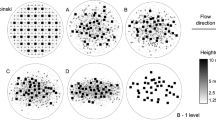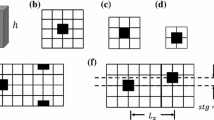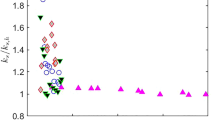Abstract
A wind-tunnel experiment has been used to investigate momentum absorption by rough surfaces with sparse random and clustered distributions of roughness elements. An unusual (though longstanding) method was used to measure the boundary-layer depth δ and friction velocity u * and thence to infer the functional relationship z 0/h = f(λ) between the normalised roughness length z 0/ h and the roughness density λ (where z 0 is the roughness length and h the mean height of the roughness elements). The method for finding u * is based on fitting the velocity defect in the outer layer to a functional form for the dimensionless velocity-defect profile in a canonical zero-pressure-gradient boundary layer. For the conditions investigated here, involving boundary layers over sparse roughness with strong local heterogeneity, this velocity-defect-law method is found to be more robust than several alternative methods for finding u * (uw covariance, momentum integral and slope of the logarithmic velocity profile).
The experimental results show that, (1) there is general agreement in the relationship z 0/h = f(λ) between the present experiment with random arrays and other wind-tunnel experiments with regular arrays; (2) the main effect of clustering is to increase the scatter in the z 0/h = f(λ) relationship, through increased local horizontal heterogeneity; (3) this scatter obscures any trend in the z 0/h = f(λ) relationship in response to clustering; and (4) the agreement between the body of wind-tunnel data (taken as a whole) and field data is good, though with scatter for which it is likely that a major contribution stems from local horizontal heterogeneity in the field.
Similar content being viewed by others
References
Arya S.P.S. (1975). ‘A Drag Partition Theory for Determining the Large-Scale Roughness Parameter and Wind Stress on the Arctic Pack Ice’. J. Geophys. Res. 80:3447–3454
Ayotte K.W. and Hughes D.E. (2004). ‘Observations of Boundary-Layer Wind-Tunnel Flow Over Isolated Ridges of Varying Steepness and Roughness’. Boundary-Layer Meteorol. 112:525–556
Batchelor G.K. (1967). An Introduction to Fluid Dynamics. Cambridge University Press, Cambridge, 615 pp.
Brunet Y., Finnigan J.J., and Raupach M.R. (1994). ‘A wind-tunnel study of air-flow in Waving Wheat: Single-Point Velocity Statistics’. Boundary-Layer Meteorol. 70:95–132
Clauser F.H. (1956). ‘The Turbulent Boundary Layer’. Adv. Appl. Mech. 4:1–51
Garratt J.R.: 1977, Aerodynamic Roughness and Mean Monthly Surface Stress over Australia, CSIRO Division of Atmospheric Physics Technical Paper 29, CSIRO, Melbourne.
Hinze J.O. (1975). Turbulence. McGraw-Hill, New York, 790 pp.
Hughes D. E. and Böhm M.: 2000, A Hitchhiker’s Guide to the Pye Laboratory Wind Tunnel, CSIRO Land and Water Technical Report 10/00.
Marshall J.K. (1971). ‘Drag Measurements in Roughness Arrays of Varying Density and Distribution’. Agric. Meteorol. 8:269–292
Minvielle F., Marticorena B., Gillette D.A., Lawson R.E., Thompson R., and Bergametti G. (2003).‘Relationship Between the Aerodynamic Roughness Length and the Roughness Density in Cases of Low Roughness Density’ Environ. Fluid Mech. 3:249–267
Raupach M.R. (1992). ‘Drag and Drag Partition on Rough Surfaces’. Boundary-Layer Meteorol. 60:375–395
Raupach M.R. (1994). ‘Simplified Expressions for Vegetation Roughness Length and Zero-plane Displacement as Functions of Canopy Height and Area Index’, Boundary-Layer Meteorol. 71:211–216
Raupach M.R., Thom A.S., and Edwards I. (1980). ‘A Wind-Tunnel Study of Turbulent Flow Close to Regularly Arrayed Rough Surfaces’. Boundary-Layer Meteorol. 18:373–397
Raupach M.R., Coppin P.A., and Legg B.J. (1986). ‘Experiments on Scalar Dispersion within a Model Plant canopy, Part I: The Turbulence Structure’. Boundary-Layer Meteorol. 35:21–52
Raupach M.R., Antonia R.A., and Rajagopalan S. (1991). ‘Rough-Wall Turbulent Boundary Layers’. Appl. Mech. Rev. 44: 1–25
Seginer I. (1974). ‘Aerodynamic Roughness of Vegetated Surfaces’. Boundary-Layer Meteorol. 5:383–393
Tennekes H. and Lumley J.L. (1972). A First Course in Turbulence. MIT Press, Cambridge, Massachusetts, 300 pp.
Wooding R.A., Bradley E.F., and Marshall J.K. (1973). ‘Drag Due to Regular Arrays of Roughness Elements of Varying Geometry’. Boundary-Layer Meteorol 5:285–308
Yaglom A.M. (1979). ‘Similarity Laws for Constant-Pressure and Pressure-Gradient Turbulent Wall Flows’. Ann. Rev. Fluid Mech. 11:505–540
Author information
Authors and Affiliations
Corresponding author
Rights and permissions
About this article
Cite this article
Raupach, M.R., Hughes, D.E. & Cleugh, H.A. Momentum Absorption in Rough-Wall Boundary Layers with Sparse Roughness Elements in Random and Clustered Distributions. Boundary-Layer Meteorol 120, 201–218 (2006). https://doi.org/10.1007/s10546-006-9058-4
Received:
Published:
Issue Date:
DOI: https://doi.org/10.1007/s10546-006-9058-4




